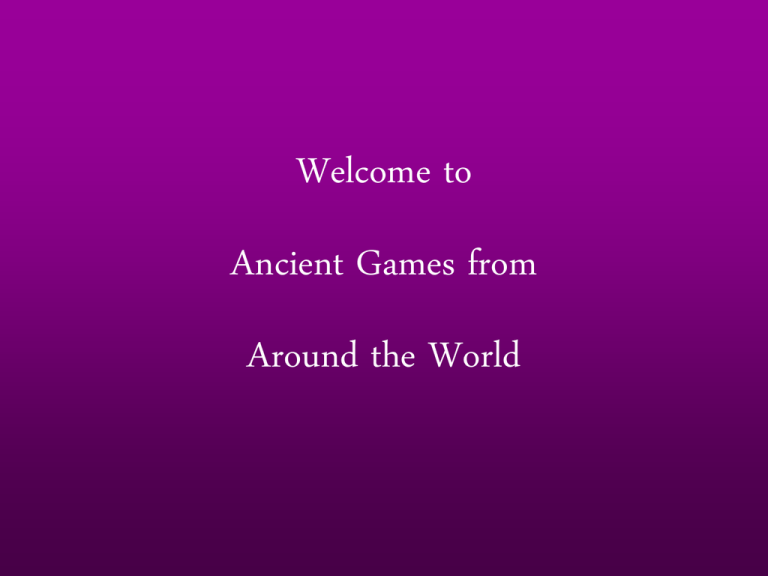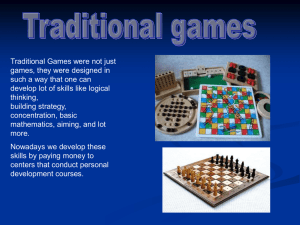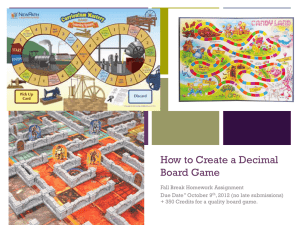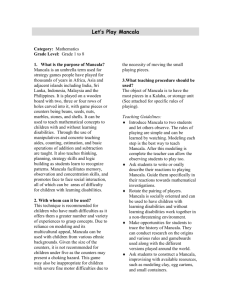click here for Ancient GamesPowerpoint Presentation
advertisement

Welcome to Ancient Games from Around the World Liam Heston Dogs & Jackals - Egypt DOGS & JACKALS Liam Heston This game’s name and rules have been forgotten among the mists of the past. We know of it by way of a famous boardgame found in an Egyptian tomb. It belongs to a family of games named "game of the thirty points" or "game of the fifty eight holes". Many gameboards or pieces of gameboards have been discovered in Egypt but also in Palestine, Mesopotamia and Assyria. A very nice boardgame has been found in the tomb of Reny-Seneb, XII dynasty, about 1800 BC. This beautiful game in ebony and ivory, has the shape of a small piece of furniture. The gameboard is a rectangular (15x10cm) wooden box, put on four animal legs. The top in ivory is carved with a palm tree and fifty eight holes. DOGS & JACKALS Liam Heston In the drawer within the box, ten pawns were found. They look like short sticks, five carved with a dog head and five with a jackal head. The pawns were placed in the holes of the gameboard. The game is for two players. Five dogs are given to one and five jackals to the other. You will need three pieces of money to use to determine movement. The goal is to reach the five points (25 to 29) on your side of the board and win the dates. Nicholas Stilwell Senet - Egypt SENET Nicholas Stilwell Senet may be the oldest board game in the world. It has been found in Predynastic and First Dynasty burials of Egypt, circa 3500 BC and 3100 BC respectively. Senet is also featured in a painting from the tomb of Merknera (3300–2700 BC). Another painting of this ancient game is from the Third Dynasty tomb of Hesy (c. 2686–2613 BC). It is also depicted in a painting in the tomb of Rashepes (c. 2500 BC). By the time of the New Kingdom in Egypt (1567–1085 BC), it had become a kind of talisman for the journey of the dead. Because of the element of luck in the game and the Egyptian belief in determinism, it was believed that a successful player was under the protection of the major gods of the national pantheon: Ra, Thoth, and sometimes Osiris. SENET Nicholas Stilwell Consequently, Senet boards were often placed in the grave alongside other useful objects for the dangerous journey through the afterlife and the game is referred to in Chapter XVII of the Book of the Dead. The game was also adopted in the Levant and as far as Cyprus and Crete but with apparently less religious significance. The Senet gameboard is a grid of 30 squares, arranged in 3 rows of 10. A senet game has 2 sets of pawns (at least 5 of each and, in some sets, more). The actual rules of the game are a topic of some debate, although historians have made educated guesses. Timothy Kendall and R.C. Bell are 2 Senet historians who have proposed (different) sets of rules to play the game. These rules have been adopted by different companies which make Senet sets for sale today. Seth Borrayo Parcheesi – India PARCHEESI Seth Borrayo Parcheesi is an American adaptation of the Indian Cross and Circle game Pachisi. Created in India around 500 BC, the game is often subtitled Royal Game of India because royalty supposedly played using costumed dancers as pieces on large outdoor boards. The game and its variants are known worldwide; for example, a similar game called Parchis is especially popular in Spain, and Parques is a Colombian variant. The German name is "Mensch argere dich nicht" (English: "Man, don't get mad"). PARCHEESI Seth Borrayo Parcheesi is played with one or two dice and the goal of the game is to move each of one's pieces home to the center space. The most popular Parcheesi boards in America have 72 spaces around the board, twelve of which are darkened safe spaces where a piece cannot be captured. On each turn, players throw one or both dice and use the values shown to move their pieces around the board. If an amount on one or both of the dice cannot be moved, that amount is forfeited. Any time a player rolls, he must use as much of the dice showing as possible. (i.e. If a player rolls 4 and 5 and could move either 4 or 5, but not both, then he must move 5.) Sam Bigham Chess - India & Southern Europe CHESS Sam Bigham The current form of chess emerged in Southern Europe during the second half of the 15th century after evolving from a similar, much older game of Indian origin. Today, chess is one of the world's most popular games, played by millions of people worldwide at home, in clubs, online, by correspondence, and in tournaments. The game is played on a chessboard, which is a square-checkered board with 64 squares arranged in an 8x8 grid. At the start, each player controls 16 pieces: 1 king, 1 queen, 2 rooks, 2 knights, 2 bishops, and 8 pawns (one using white pieces, the other black pieces). The object of the game is to checkmate the opponent's king, whereby the king is under immediate attack (in "check") and there is no way to remove it from attack on the next move. CHESS Sam Bigham Chess is commonly believed to have originated in India during the Gupta empire, where its early form in the 6th century was known as caturaga (Sanskrit: four divisions [of the military] – infantry, cavalry, elephants, and chariotry, represented by the pieces that would evolve into the modern pieces. In Sassanid Persia around 600 the name became shatranj and the rules were developed further. The game reached Western Europe and Russia by the 9th century. In the 18th century the center of European chess life moved from the Southern European countries to France. As the 19th century progressed, chess organization developed quickly. Many chess clubs, chess books and chess journals appeared. Chess problems became a regular part of 19th-century newspapers. Jackie Bonner Go – China, Japan & Korea GO Jackie Bonner Go is a strategic board game for 2 players. It is also known as igo (Japanese), weiqi or wei ch'i (Chinese) or baduk (Korean). Go is noted for being rich in strategic complexity despite its simple rules. The game is played by two players who alternately place black and white stones (playing pieces, now usually made of glass or plastic) on the vacant intersections of a grid of 19×19 lines. The object of the game is to control a larger portion of the board than the opponent. A stone or a group of stones is captured and removed if it has no empty adjacent intersections, the result of being completely surrounded by stones of the opposing color. Placing stones close together helps them support each other and avoid capture. On the other hand, placing stones far apart creates influence across more of the board. Part of the strategic difficulty of the game stems from finding a balance between such conflicting interests. Go originated in ancient China more than 2,500 years ago, and although it is not known exactly when the game was invented, by the 3rd century BC it was already a popular pastime, as indicated by a reference to the game in the Analects of Confucius. Archaeological evidence shows that the early game was played on a board with a 17×17 grid, but by the time that the game spread to Korea and Japan in about the 7th century boards with a 19×19 grid had become standard. The game is most popular in East Asia, but has gained some popularity in other parts of the world in recent years. A conservative estimate places the number of go players worldwide at approximately 27 million. Go reached the West through Japan, which is why it is commonly known internationally by its Japanese name. Aaryan Booter Tafl - Scandinavia TAFL Aaryan Booter Tafl games were a family of ancient Germanic and Celtic board games played on a checkered or latticed board with 2 teams of uneven strength. The size of the board and the number of pieces varied, but all games involved a distinctive 2:1 ratio of pieces, with the lesser side having a kingpiece which started in the centre. The king's objective was to escape to the board's periphery or corners, while the greater force's objective was to capture him. The term tafl (Old Norse: "table", "board") is the original name of the game. However, Hnefatafl became the preferred term for the game in Scandinavia by the end of the Viking Age, to distinguish it from other board-games, such as Skáktafl (Chess), Kvatrutafl (Tables) and Halatafl (Fox games). In Anglo-Saxon England, the term tæfl also referred to many board-games. TAFL Aaryan Booter Several games may be confused with tafl games, due to the inclusion of the word "tafl" in their names or other similarities. Halatafl is the Old Norse name for Fox and Geese, a game dating from at least the 14th century. It is still known and played in Europe. Kvatrutafl is the Old Norse name for Tables (the medieval forerunner of Backgammon). Skáktafl is the Old Norse name for Chess. Fidchell or Fithcheall (Modern Irish: Ficheall) was played in Ireland. The Welsh equivalent was Gwyddbwyll and the Breton equivalent Gwezboell; all terms mean "wood-sense". This popular medieval game was played with equal forces on each side and thus was not a tafl variant, but rather may have been the medieval descendant of the Roman game Latrunculi or Ludus latrunculorum. Michael A. Chandler Mancala Ethiopia, Petra, Western Africa MANCALA Michael Chandler Mancala is a family of board games played around the world, sometimes called "sowing" games, or "countand-capture" games, which describes the game-play. Mancala games play a role in many African and some Asian societies comparable to that of chess in the West. The list of mancala games best known in the Western world includes Kalah and Oware. Other games are Congkak, Omweso, Ünee tugaluulakh, Bao, Sungka and Igisoro. The word mancala comes from the Arabic word naqala meaning literally "to move." There is no one game with the name mancala; instead mancala is a type, or designation, of game. Mancala games share a common general gameplay sequence. Players begin by placing a certain number of seeds, prescribed by the variation in use, in each of the pits on the game board. A player may count their stones to plot the game. A turn consists of removing all seeds from a pit, sowing the seeds and capturing based on the state of board. This leads to the MANCALA Michael Chandler English phrase "Count and Capture". Although the details differ greatly, this general sequence applies to all games. The first evidence of the game are fragments of a pottery board and several rock cuts found in Aksumite Ethiopia in Matar (now in Eritrea) and Yeha (in Ethiopia), which are dated by archaeologists to between the 6th and 7th century AD. The USA has a large mancala playing population. A traditional mancala game called Warra was still played in Louisiana in the early 20th century. In Cape Verde, Mancala is known as "ouril". It is played in the Islands and was brought to America by Cape Verdean immigrants. It is played to this day in Cape Verdean communities in New England. Haley Banks Baguenaudier Chinese Rings – China BAGUENAUDIER CHINESE RINGS Haley Banks Baguenaudier (also known as the Chinese Rings, Cardan's Suspension, or five pillars puzzle) is a mechanical puzzle featuring a double loop of string which must be disentangled from a sequence of rings on interlinked pillars. The puzzle is thought to have been invented originally in China. Stewart Culin provided that it was invented by the Chinese general Zhuge Liang in the 2nd century AD. The name "Baguenaudier", however, is French. BAGUENAUDIER CHINESE RINGS Haley Banks In fact, the earliest description of the puzzle in Chinese history was written by Yang Shen, a scholar in 16th century in his Dan Qian Zong Lu (Preface to General Collections of Studies on Lead). Édouard Lucas, the inventor of the Tower of Hanoi puzzle, was known to have come up with an elegant solution which used binary and Gray codes, in the same way that his puzzle can be solved. Sam Bigham Dominoes – India, China & Italy DOMINOES Sam Bigham Domino pieces were historically carved from ivory or animal bone with small, round pips of inset ebony. The game's name comes from the pieces' resemblance to Venetian Carnival masks known as domini, which were white with black spots. The oldest domino sets have been dated from around 1120. Modern dominoes, as most of the Western world knows them, however, appear to be a Chinese invention. They were apparently derived from cubic dice, which had been introduced into China from India some time in the distant past. Each domino originally represented one of the 21 results of throwing two dice. Chinese dominoes are also longer than typical European dominoes. Over time Chinese dominoes also evolved into the tile set used to play Mah Jong. DOMINOES Sam Bigham The early 18th century witnessed dominoes making their way to Europe, making their first appearance in Italy. The game changed somewhat in the translation from Chinese to the European culture. European sets contain 7 additional dominoes, with 6 of these representing the values that result from throwing a single die with the other half of the tile left blank, and the 7th domino representing the blank-blank (0-0) combination. Most domino games are blocking games, i.e. the objective is to empty one's hand whilst blocking the opponents. In the end, a score may be determined by counting the pips in the losing players' hands. In scoring games the scoring is different and happens mostly during gameplay, making it the principal objective. Backgammon – Persia Jackie Bonner BACKGAMMON Jackie Bonner Backgammon is a board game for two players in which the playing pieces are moved according to the roll of dice. Players win by removing all of their pieces from the board. There are many variants of backgammon, most of which share common traits. Backgammon is a member of the tables family, one of the oldest classes of board games in the world. Although luck plays an important role, there is a large scope for strategy. With each roll of the dice players must choose from numerous options for moving their checkers and anticipate possible counter-moves by the opponent. Players may raise the stakes during the game. There is an established repertoire of common tactics and occurrences. Like chess, backgammon has been studied with great interest by computer scientists. Owing to this research, backgammon software has been developed capable of beating world-class human players. BACKGAMMON Jackie Bonner Backgammon playing pieces are known variously as checkers, stones, men, counters, pawns, or chips. The objective is to remove (bear off) all of one's own checkers from the board before one's opponent can do the same. The checkers are scattered at first and may be blocked or hit by the opponent. As the playing time for each individual game is short, it is often played in matches, where victory is awarded to the first player to reach a certain number of points. The Royal Game of Ur, played in ancient Mesopotamia, is a likely ancestor of modern day table games. Excavations at Shahr-e Sokhteh (Persian شهر سوخته, literally "The Burnt City") in Iran have shown that a similar game existed there around 3000 BC. The artifacts include two dice and 60 checkers, and the set is believed to be 100 to 200 years older than the sets found in Ur. Michael Chandler Patolli - Aztec PATOLLI Michael Chandler Patolli (the Nahuatl name) or patole (the Spanish form) is one of the oldest games in America. Patolli (or variants of it) was played by a wide range of pre-Columbian Mesoamerican cultures and known all over Mesoamerica. Patolli was a game of commoners and nobles alike and it was reported by the conquistadors that Montezuma often enjoyed watching his nobles play the game at court. The object of the game is for a player to win all of the opponent's treasure. To do this, the players may need to play more than one round of the game. In order to complete a round, a player needs to get all of the six jade markers from the starting queue position to the ending square position on the game board before the other player. The jade stone markers come in two colors. One player would have an assortment of red colored jade markers. The other player would have an assortment of blue colored jade markers. PATOLLI Michael Chandler In order to get one of the jade stone markers on the board, the player tosses five specially prepared kidney beans on the game area. The kidney beans, or patolli, has one side marked with a white dot. Thus tossing the patolli would result in several patolli showing this white mark and others showing a blank side. In order to get on the game board, one patolli would have to land with the white mark face up and all the others face down (getting a score of one). The players take turns tossing. Once a player is able to get on the board, the game begins and the player is allowed to place one of the jade markers from the queue onto the starting square of the game board. The game board is shaped like a capital letter X that has square and triangular shaped landing positions marked on it that run down one side and back up the other side of the X. There are 52 landing positions in all. The game board could be drawn on a bit of leather or on a straw mat and decorated with colored dye or it could also be carved into the floor or table top. Deneen Underwood Royal Game of Ur – Sumeria ROYAL GAME OF UR Deneen Underwood In 1926-27, the British archeologist Leonard Woolley, while excavating in the royal tombs of Sumer (modern Iraq), discovered four game boards and a number of playing pieces. The tombs were in the city of Ur (in red on the map on the left), once the capital of Sumer about 2500 B.C., and the legendary home of the Biblical Abraham. This area is in the "fertile crescent", south of Baghdad and Babylon. The Museum document collection includes a number of references to Woolley's discovery, complete with a number of colorful photographs such as the one below. Woolley's finds are now held by the British Museum. ROYAL GAME OF UR Deneen Underwood This game is similar to the Egyptian game of Senet, though it is a variation of the Egyptian game in that there are a reduced number of cells on the Ur board. Both game boards contain a drawer which holds the playing pieces and binary lots which are used like dice are used in a contemporary board game to determine the moves of the pieces. As do some of the Senet boards, some of the Ur boards include conical rather than flat pieces. Throw-sticks or lots were included as a chance device in both games. It appears to be a game for two players who alternate their moves on the board. Various markings on the board (such as the "rosettes") appear to have had some consequence in the play of the game if a piece lands on one of these squares - sort of like in a contemporary board game - "loose one turn", "go back three spaces", etc.







